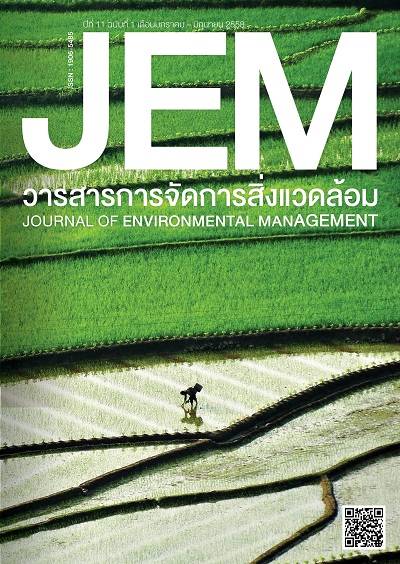การจัดการมลพิษทางน้ำโดยวิธีการมีส่วนร่วมของชุมชน ในพื้นที่ลุ่มน้ำปาย จังหวัดแม่ฮ่องสอน Community Water Pollution Management Using a Participative Approach in the Pai Watershed, Mae Hong Son
DOI:
https://doi.org/10.14456/jem.2015.2บทคัดย่อ
การวิจัยเรื่อง การจัดการมลพิษทางน้ำโดยวิธีการมีส่วนร่วมของชุมชนในพื้นที่ลุ่มน้ำปาย จังหวัดแม่ฮ่องสอน มีวัตถุประสงค์หลักคือ การสร้างรูปแบบการจัดการมลพิษทางน้ำที่เหมาะสมกับพื้นที่โดยชุมชนสามารถดำเนินการได้เอง พบว่า ปัญหามลพิษของแหล่งน้ำในพื้นที่ลุ่มน้ำปายที่เป็นปัญหามากที่สุด ได้แก่ น้ำในแหล่งน้ำมีตะกอนขุ่นมาก ในส่วนของรูปแบบในการแก้ปัญหามลพิษทางน้ำในพื้นที่ลุ่มน้ำปาย ซึ่งสามารถนำมาปฏิบัติได้จริงในชุมชน ประกอบด้วย การร่วมกันสังเคราะห์และวิเคราะห์ปัญหาทรัพยากรน้ำในพื้นที่ลุ่มน้ำปาย การสำรวจและตรวจวิเคราะห์คุณภาพน้ำ สร้างความตระหนักและความรู้ให้กับประชาชนและเยาวชน การอบรมเชิงปฏิบัติการการทำถังดักไขมัน ซึ่งสามารถลดน้ำเสียที่มีไขมันที่ปล่อยลงสู่แหล่งน้ำสาธารณะได้อย่างน้อยวันละ 500 ลิตร จากถังดักไขมันที่ทำขึ้น 25 ถัง การทำฝายชะลอน้ำและตะกอน จำนวน 5 ฝาย การทำแนวป้องกันไฟป่าและการปลูกหญ้าแฝก เพื่อลดการพังทลายของดิน รวมทั้งการสร้างเครือข่ายกลุ่มเยาวชนและประชาชนโดยมีเครือข่ายเยาวชนเกิดขึ้นจากโรงเรียนในพื้นที่จำนวน 6 โรงเรียน ผลจากการดำเนินการกิจกรรมตามรูปแบบดังกล่าวทำให้ประชาชนและเยาวชนมีความรู้และความตระหนักในการจัดการทรัพยากรน้ำมากขึ้น
This research has the main objective to establish an optimal pattern of community water pollution management in the Pai watershed area using the Participatory Action Research (PAR) approach. The results showed that the important problem concerning the water in the Pai watershed was the sediment which created turbidity in the river. The pattern for solving these water pollution problems in the Pai Watershed area which was proper and lead to action in this community was first, motivating the people in the community to realize the problems in their own community. Then, people in the community participated in designing a pattern for solving their problems by cooperating with researchers, surveying and analyzing the quality of the water, building consciousness and knowledge on the part of the teenagers and people in the community. Activities include training in the construction of a grease trap tank (from the construction of 25 grease trap tanks which could reduce the water pollutants at 500 liters per day), constructing 5 dams to reduce the water irrigation, setting up fire protection line area for the protection of the forest, growing vetiver grass in the area for the protection of the soil against erosion, especially in the area near the river bank of the Pai watershed area, and finally gathering the environmental conservation group of teenagers from 6 schools.
เอกสารอ้างอิง
Adler, P. S., Barrett, R. C., Bean, M. C., Birkhoff, J. E., Ozawa, C. P. & Rudin, E. B. (2000). Managing Scientific and Technical Information in Environmental Cases: Principles and Practices for Mediators and Facilitators. Washington, DC: RESOLVE Inc.; US Institute for Environmental Conflict Resolution; Western Justice Center Foundation.
Anderson, S. D. (1999). Watershed Management and Nonpoint Source Pollution: The Massachusetts Approach. Boston College Environmental Affairs Law Review, 26(2), 339 - 386.
Announcement of the National Environment Committee, Issue 8 (1994). Surface Water Quality Standard [In Thai: ประกาศคณะกรรมการสิ่งแวดล้อมแห่งชาติ ฉบับที่ 8 (พ.ศ. 2537) เรื่องกำหนดมาตรฐานคุณภาพน้ำในแหล่งน้ำผิวดิน]. In Royal Government Gazette, 111, Part 16 Ngor, dated February 24, 1994 (pp. 234 – 240). National Environment Committee, Thailand.
Apichartkriengkrai, S. (2000). Public participation in water resource management: A case study of Lamtakong Basin, Nakhon Ratchasima Province [In Thai: การมีส่วนร่วมของประชาชนในการจัดการทรัพยากรน้ำ กรณีพื้นที่ลุ่มน้ำลำตะคอง จังหวัดนครราชสีมา]. Master’s Thesis. Chiang Mai University.
Boontanuttapong, A. (2006). Participatory Action Research [In Thai: การวิจัยเชิงปฏิบัติการแบบมีส่วนร่วม]. Pranakhon Rajabhat Researh Journal, 1(1), 19 – 26.
Bradbury, H. & Reason, P. (2003). Issues and choice points for improving the quality of action research. In M. Minkler & N. Wallerstein (eds.), Community-based Participatory Research for Health (pp. 201 – 220). San Francisco, CA: Jossey-Bass.
Hall, B. L. (1992). From Margins to Center? The Development and Purpose of Participatory Research. The American Sociologist, 23(4), 15 – 28.
Hogan. C. M. (2010). Water pollution. In M. McGinley & C. Cleveland (eds.), Encyclopedia of Earth. Washington, DC: National Council on Science and the Environment.
Mark, L, Mark, S, John, T. & Mihriye, M. (2002). Watershed Partnerships and the Emergence of Collective Action Institutions. American Journal of Political Science, 46(1), 148 – 163.
Ngenprasertsri, N. (2001). The Participatory Action Research [In Thai: การวิจัยเชิงปฏิบัติการแบบมีส่วนร่วม]. Journal of Social Science and Humanities, 27, 61-72.
Novotny, V. (2003). Water Quality: Diffuse Pollution and Watershed Management. New York: J. Wiley and Sons.
Phukaew, D. (2005). A Study of utilization and participation of community in water resource management. [In Thai: ศึกษาสภาพและการใช้ประโยชน์และการมีส่วนร่วมของชุมชนในการจัดการทรัพยากรน้ำ]. Unpublished Master’s Thesis. Chiang Mai University.
Prabhakar, K., Lavanya, K. & Papa, R. A. (2010). NGOs and Farmers Participation in Watershed Development Program in Prakasam District. Asia-Pacific Journal of Social Science, 2(1), 173 – 182.
Rammasooth, P. (1997). The Participatory Action Research [In Thai: การวิจัยเชิงปฏิบัติการแบบมีส่วนร่วม]. Bangkok: ASEAN Institute for Health Development, Mahidol University.
Rapeepat, A. (1988). The transformation of Tombon Yokkrabat, Changwat Samut Sakorn and Problems in Rural Development work. [In Thai: ปัญหาการพัฒนาชนบท: บทเรียนจากกรณียกกระบัตร โครงการพัฒนาชนบทลุ่มน้ำแม่กลอง]. Khon Kaen: Institute of Research and Development, Khon Kaen University.
Walaisateine, P. (2000). Community and the Community Characteristics [In Thai: ชุมชนและลักษณะความเป็นชุมชน]. In Proceeding of the 1st Annual Meetings on Community, Thai Community amidst changes (pp. 1 – 14). Bangkok: Thailand Research Fund.



